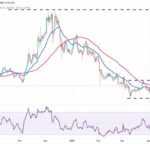In a surprising turn of events in the cryptocurrency world, Ripple, the issuer of the XRP token, has reportedly made an unsuccessful bid to acquire Circle, the company behind the popular USDC stablecoin. According to sources cited by Bloomberg, while Ripple remains interested in Circle, no definitive decision has been reached regarding a new offer. This news highlights an ongoing trend in the crypto industry, where companies are increasingly exploring mergers and acquisitions to strengthen their market positions.
Ripple has recently ventured into the stablecoin market with its own creation, RLUSD, which boasts a market capitalization of just over $300 million. In contrast, Circle’s USDC has established itself as a major player with a staggering market cap exceeding $60 billion. This stark difference underscores the competitive landscape and the potential advantages that come with a substantial user base and recognition.
“Circle is among a growing number of crypto-related companies aiming to go public in the near future,”
as the race for expanding market share and authority in the digital currency sector heats up. The cryptocurrency landscape continues to evolve, with companies like Ripple and Circle at the forefront of innovation, shaping the future of how we perceive and use digital assets.

Ripple’s Strategic Moves in the Cryptocurrency Market
Ripple, a prominent player in the cryptocurrency space, is taking significant steps that could have lasting impacts on both the market and individual investors. Here are the key points regarding Ripple’s recent actions:
- Ripple’s Acquisition Attempt:
- Ripple attempted to acquire Circle, the issuer of the USDC stablecoin, but was rejected.
- Despite the rejection, Ripple remains interested in Circle, indicating potential future moves.
- Launch of RLUSD Stablecoin:
- Ripple has launched its own stablecoin, RLUSD, which currently holds a market capitalization of just over $300 million.
- This position suggests Ripple is strategically diversifying its offerings in the stablecoin market.
- Comparison with USDC:
- Circle’s USDC stablecoin boasts a market cap exceeding $60 billion, highlighting its dominance in the market.
- The substantial difference in market capitalization may influence Ripple’s future strategies and partnerships.
- Market Impact:
- Cirlce aims to go public, which may affect the competitive landscape of stablecoins and the broader cryptocurrency market.
- Potential public offerings could introduce new investment opportunities and volatility in crypto markets.
Ripple’s ongoing interest in acquiring Circle suggests potential future consolidation in the stablecoin market, which could reshape investment opportunities for individuals involved in cryptocurrencies.
Ripple’s Ambitious Moves in the Stablecoin Space: A Comparative Analysis
The recent news surrounding Ripple and its foray into the stablecoin market with RLUSD, coupled with its attempted acquisition of Circle, the issuer of USDC, paints a compelling picture of the evolving landscape in the cryptocurrency realm. Ripple’s RLUSD is still finding its footing with a market cap of around $300 million, significantly dwarfed by Circle’s USDC, which boasts a staggering $60 billion market cap. This vast disparity is one of the key competitive advantages for Circle, showcasing a well-established and trusted position in the market.
Ripple’s Position and the Competitive Disadvantages
While Ripple’s ambitions are clear, its challenges are equally pronounced. The rejection of its buyout attempt signals a resistance to collaboration from established players in the space, which could hinder Ripple’s growth strategy. Furthermore, with a smaller market cap, RLUSD may struggle to gain the level of trust and recognition that USDC commands among institutional and retail investors alike. This trust factor, pivotal in the crypto ecosystem, is often a deciding element for users when choosing a stablecoin.
Potential Benefits for Ripple and Challenges for Circle
If Ripple manages to bolster RLUSD’s adoption, it could benefit greatly from being seen as a serious competitor in the stablecoin arena. Moreover, if the company decides to make another offer for Circle, it could create a significant consolidation in the market, reshaping the landscape. Conversely, Circle’s goal to go public presents its own set of challenges, as it must navigate the regulatory environment and maintain market confidence amid growing competition from companies like Ripple. Any major shifts, such as a buyout or increased regulatory scrutiny, could stir volatility in USDC’s stability, potentially creating problems for its supporters.
Who Stands to Gain or Lose?
Investors and users of RLUSD may eventually find benefits if Ripple’s strategies lead to increased adoption and innovation within their stablecoin offerings. On the flip side, if Ripple’s ambitions falter, it could create disadvantages for Ripple’s current stakeholders and investors, diminishing confidence in its products. For Circle, maintaining its position as a leading stablecoin issuer is essential, and any disruptions—be it from Ripple’s continued interest or internal challenges while going public—could pose risks that might affect USDC’s stature in the crypto market.

















